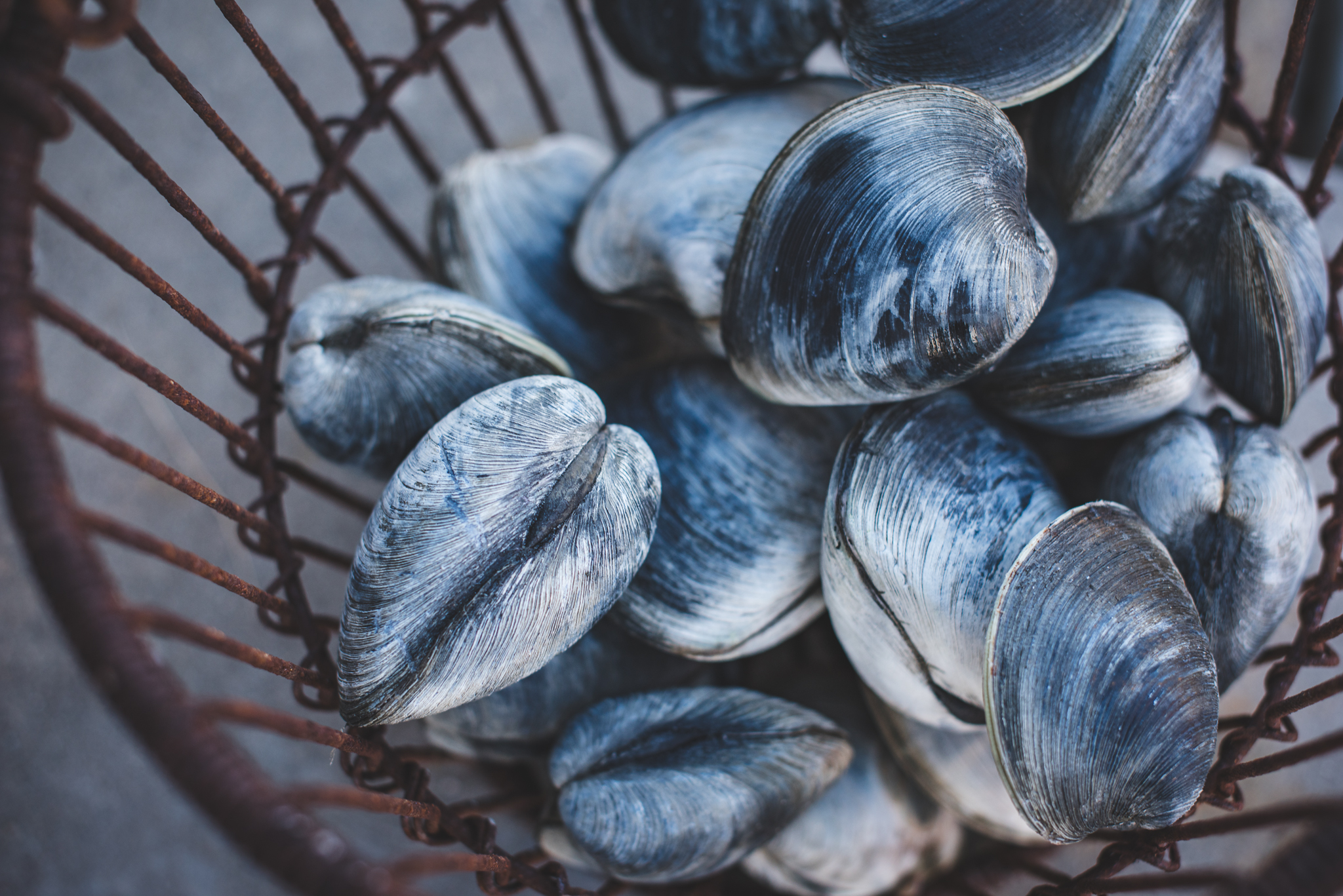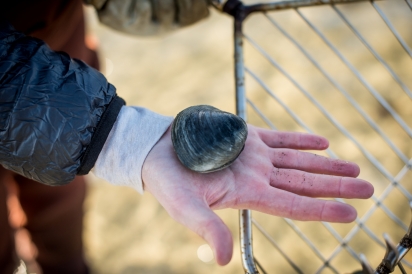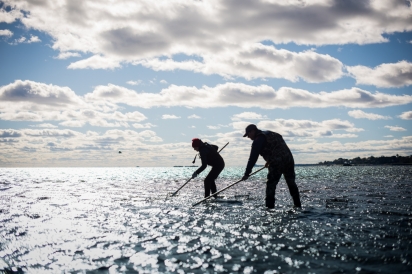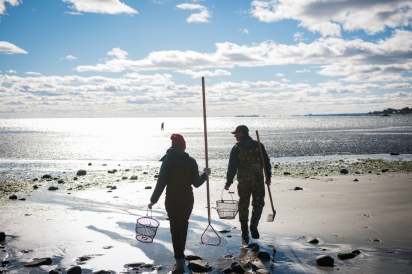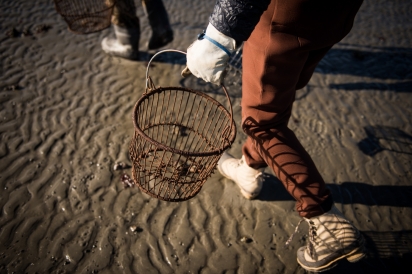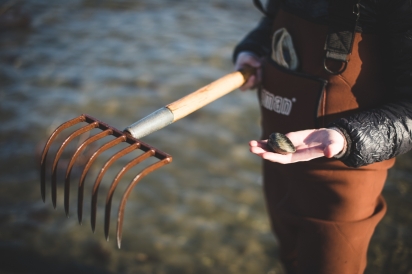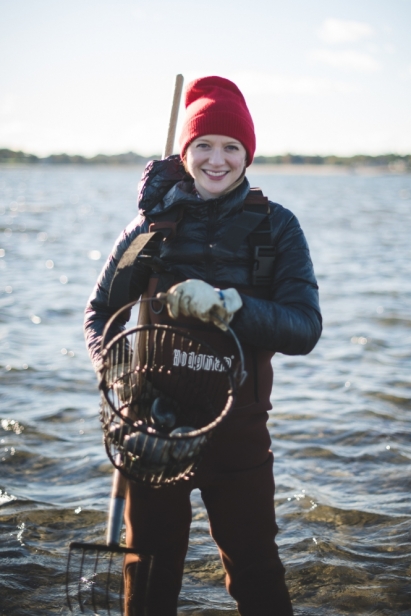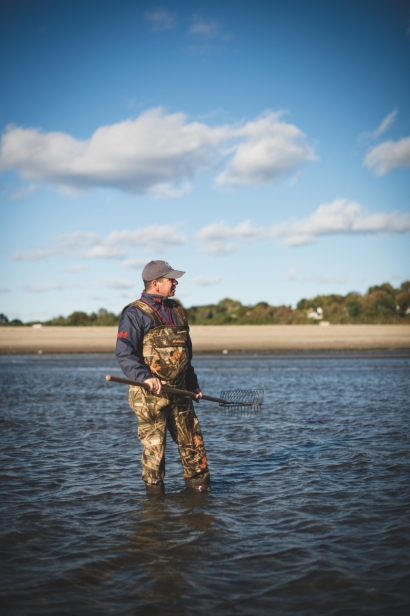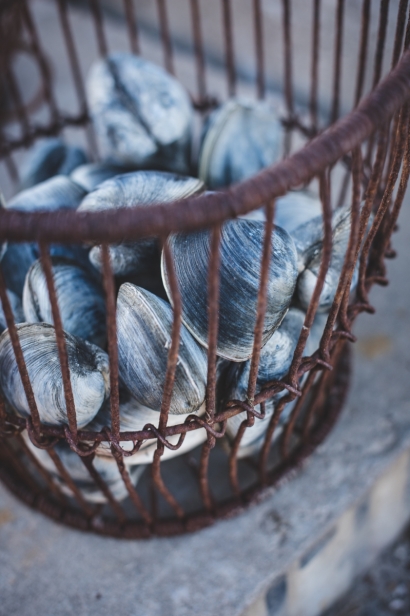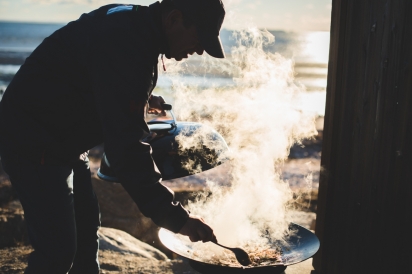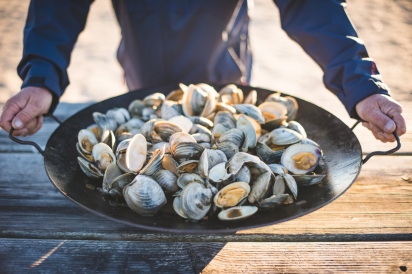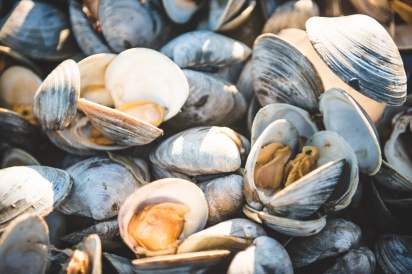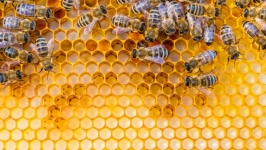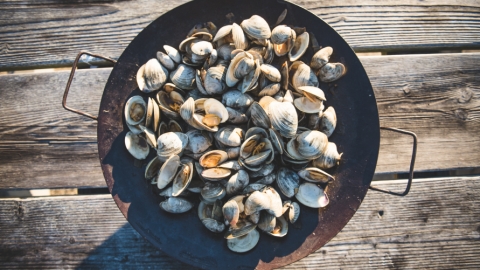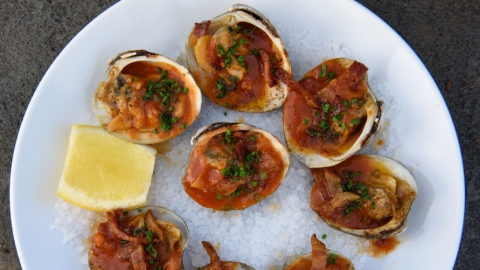The Hunt: In Pursuit of Connecticut's Quahogs
It was for the wind as much as anything.
It was for the tidal flats, for the miles of bars
and the freezing runs between them,
blued and darkened in the withering gusts.
For the buckets, for the long-tined rakes.
For our skin burning and the bones
beneath, all their ache. For the bent backs,
for the huddle toward warmth beneath
our incapable layers, how we beat
ourselves with our arms. The breath
we blew, the narrow steam that spun away.
How we searched their tell-draggle marks.
Then the feel of them as we furrowed. Then it
was surgery and force together. Like stones.
Opal or pearl or plain rock, ugly except
they were beautiful, their whorls and
purple stains. The bucket’s wire cutting
with their weight. For the sky blazing, its
sinking orange fire. For the sky’s black streaks
with night rising, winter-sudden. Back,
shoreward, home, the tide creeping like a wolf.
For the little stove warming, its own orange fire.
The old pot, the steam, the air in savor,
the close room, the precious butter, the
blue fingers throbbing, our bodies in all
the customs of weariness, the supper,
succulent of the freezing dark sea come up,
and hunger, its own happiness, its own
domain immeasurable. It was for the hunger.
Quahogs, by Frank X. Gaspar
Originally appeared in the The New Yorker, January 11, 2016
A few years ago, when my husband handed me Frank X. Gaspar’s poem, Quahogs, printed in his folded issue of The New Yorker, I was inspired and hooked by the way it connected the character of the gatherer to the precious thing being gathered. In this case, it was the quahog, or the hard shell clam. Being raised in Fairfield County, I was curious about having the experience of shellfishing in the winter months for myself. So, on one of the final days in October, John Short, in his gray Town of Fairfield Shellfish Commissioner cap, led me down the beach, across a sandbar, and out into ankle-deep water. Armored in neoprene waders and with our wire baskets and rakes (his, the ‘Chatham Scratcher,’ an expert’s choice with its tines sharp and tempered), we got to work.
The Sound glimmered in the last bit of afternoon light; the whole of Sasco Beach in Southport was a dancing pool of silver and deep blue. The brisk wind lashed at our faces, the temperature bracing. “People don’t know you can come out and dig for clams at this time of year,” Short said, dragging his rake through the soft mud, listening for the scrape of quahog shell. “They don’t know you can come out, period.”
Though we weren’t the only souls out on the beach – there were at least two others scratching away at the sand, looking for oysters, mussels, or steamer clams – it is atypical for many to be out shellfishing this time of year. It has been the well-kept secret of shellfishing families, who share the pastime across generations, that indeed the Long Island Sound is alive and well and open for shellfishing all year. What’s a little breeze and cool weather to a salty New Englander, anyway?
“You just have to dress warm, wear boots, and bring a rake and bucket. Other than that, the clams are still there, maybe just a little bit deeper, and there isn’t really other equipment that you need,” said Tessa Getchis, aquaculture extension specialist with the Connecticut Sea Grant and UConn Extension Program. Getchis, who learned to shellfish from her father, said the thrill of the hunt for shellfish is what really draws people in and keeps them at the beaches, whatever the weather. She also explained that there’s a rich history of shellfishing in Connecticut that dates back to the Native Americans, who would lathe the shells into beads for jewelry or use them as currency to barter for other goods.
Getchis and Short both spoke, too, of the state’s strict federal guidelines that each town adheres to through collaboration with town shellfish commissions, which perform regular and stringent tests on the water to make sure the fish are safe to eat. “People think that the Sound isn’t clean,” Short said, “but it is. And folks don’t realize, either, that the shellfish they are eating in restaurants are most likely from a local catch.”
Short and I were after the humble quahog, whose various sizes have more familiar names like little neck, cherry stone, or chowder. But they are all in the quahog family and are prized in this season for chowder or stuffing or for the Christmas Feast of the Seven Fishes. But there, at Sasco, we were hoping to steam our catch up, surfside.
With the sun sinking towards the horizon and the tide creeping in, we were tiny silhouettes against the steely water. Short, who had already dropped several big quahogs into his bucket, glanced at my own, empty, and suggested that I get more length on my rake and try digging a bit deeper. “Just keep digging, and maybe you’ll find a Honey Hole,” Short said, explaining that, sometimes, you can find a spot where several clams have been hiding out together, like a jackpot, and you can rake them out all at once. “If the clam is nice and black, that’s how you know it’s alive,” Short said.
Just when my sides were starting to get sore and my eyes weepy from the breeze, I pulled on my rake and heard the tell-tale screech of a shell beneath the tines. It wasn’t a Honey Hole, but it was, for sure, a quahog. “I got one!” I called out, admiring my first clam’s glossy ridges before tossing it into my basket. The hunt was on, and there was something wild and exciting about it. When we had gathered a little more than two dozen clams, we returned to the beach to cook them up.
Short, who grew up in Fairfield and leads all kinds of shellfish programs through the town’s conservation office (including a management plan, an oyster bed project, and annual clam clinics), has a kind of reverence, it seemed, for the Sound’s delicate ecosystem. He also had an appreciation for good cooking, as he came prepared to steam the clams with his Discada (a type of large, steel wok) and all the ingredients to make their salty flavor dance, including white wine, onions, shallots, scallions, and plenty of butter.
Once the stove was smoking, Short tossed everything onto the fire, and the nutty sizzle of the butter and sharpness of the onions wafted its aroma down the beach, drawing in a few curious passersby. He threw on a bunch of clams – the ones we'd found, as well as some harvested earlier that day in Milford – and covered everything to steam it through. I was impressed. “If you’re going to do it, you’d better do it right,” he said.
At a nearby picnic table, bowls clamored to be filled with the sweet catch. Short scooped some for each of us. With chilled noses and fingers and a blaze of hunger within us, we enjoyed those quahogs with the kind of satisfaction that only working for your food can bring. Their fresh and buttery bounty is one I won’t soon forget, and I look forward to getting back to the beach, year-round permit in hand, with my young son and husband, for the hunt.
For more information about recreational clamming, including Connecticut’s 14 coastal towns that offer shellfishing permits, visit: VisitConnecticut.com/State/ShellFishing


